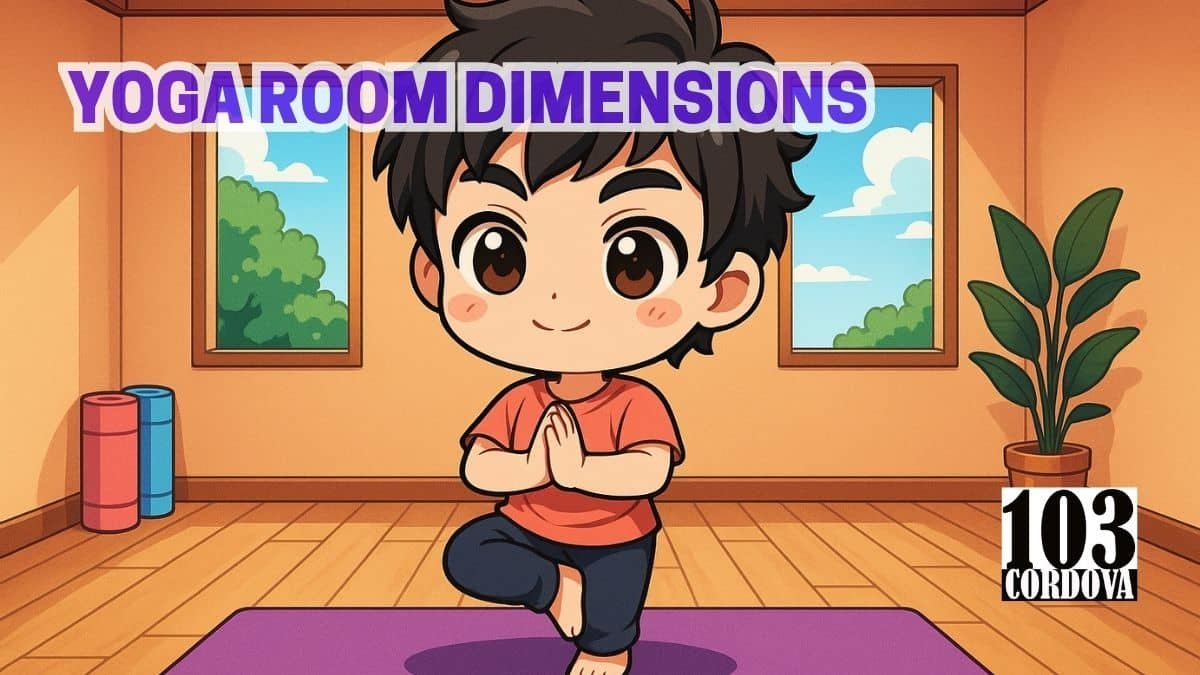The size of a yoga room affects how people feel and move during their sessions.
If the room is too small, it can limit motion and comfort.
In contrast, a room that is too large might feel empty or unfocused.
Whether you’re practicing alone or with others, the space should support calm, safety, and ease of movement.
Room dimensions are a basic but important part of creating a good yoga environment.
1. Comfortable Space For Movement
Yoga includes poses that need room to stretch arms and legs in many directions.
A crowded room can make it hard to do this properly.
When there is enough space, people can focus more on their movements without worrying about bumping into someone.
It also allows teachers to move around and help students more easily.
A well-sized room lets everyone practice without feeling restricted.
🧘 How to Create a Yoga Room Schedule That Maximizes Attendance
2. Safety Through Adequate Spacing
Many yoga poses require balance, reaching, or transitions that need clear space around the mat.
Without enough room, students might accidentally step on or hit someone nearby.
Tripping hazards increase when mats are too close.
Spacing also matters for instructors, who need room to see and assist everyone.
A safe practice space begins with a proper distance between each person.
🧘 How to Safely Practice Advanced Wheel Pose: Tips and Preparations
3. Optimal Class Capacity
Class size should match the space available.
A room that holds too many people can feel tight, hot, and noisy.
If there are too few people in a large room, it may feel awkward or empty.
Knowing how many mats fit comfortably helps instructors plan better.
A well-balanced room size improves both teaching and the group experience.
🧘 Why Creating a Dedicated Yoga Breathing Room Can Transform Your Wellness Routine
4. Personal Space And Privacy
People feel more at ease when they have space around their mats.
This is important during quiet poses or breath work, where focus matters.
For solo sessions, a spacious room gives the feeling of privacy, even without walls or barriers.
In group settings, enough space between mats helps avoid distractions.
Respecting personal space leads to a more relaxed and focused practice.
🧘 How to Choose the Perfect Ashtanga Yoga Mat for Your Practice
5. Calming Atmosphere And Ambiance
The shape and size of a room can affect how people feel when they walk in.
A room that is too narrow or small can feel tight and stuffy.
Oversized rooms might echo or feel less cozy.
Balanced dimensions help create a space that feels peaceful and welcoming.
Good lighting, quiet air flow, and open layout add to a calming atmosphere.
🧘 What Makes Bikram Yoga Positions and Benefits Unique Compared to Other Yoga Styles?
6. Flexibility For Various Class Types
Some classes use props, partners, or extra gear that take up more space.
Others may include movement-based styles that need larger areas to move freely.
A room with flexible dimensions can handle different class setups without needing big changes.
Teachers can also try new styles without worrying about space limits.
More flexibility means better variety and more options for students.
🧘 How Somatic Yoga Therapy Enhances Mind-Body Awareness for Holistic Healing
7. Room For Storage And Amenities
Yoga rooms often need space for storing mats, blocks, straps, and blankets.
Having these items nearby but out of the way makes the room cleaner and more usable.
Amenities like cubbies, benches, or water stations need room but shouldn’t crowd the practice area.
If dimensions are planned well, storage can be added without shrinking floor space.
This helps keep the room neat and organized.
🧘 How Chair Yoga Teacher Training Can Transform Your Teaching Skills and Student Engagement
8. Accessibility For All Practitioners
Rooms should be easy to use for everyone, including older adults and those with limited mobility.
Wider walkways, clear paths, and extra space help with wheelchairs or other aids.
Good spacing also makes it easier for people to enter, exit, or move around without feeling rushed.
Proper dimensions support safety and comfort for all body types and skill levels.
A welcoming room meets the needs of all who enter.
🧘 Does Yoga Tone Your Body? How to Maximize Yoga for Physical Toning
9. Enhanced Focus And Mindfulness
A crowded or noisy room can make it hard to stay focused.
When the space feels open and balanced, the mind can settle more easily.
Fewer distractions help people stay connected to their breath and movements.
Proper spacing also supports a quieter mood, which helps with mental clarity.
The size of the room sets the tone for a more mindful practice.
🧘 Reveal the Transformative Secrets of Yoga
10. Future Growth And Adaptability
Studios may want to grow their classes or try new formats in the future.
Rooms with flexible size allow for these changes without major redesign.
Adding new programs or workshops becomes easier with more space to work with.
Even simple adjustments, like moving mats or furniture, require room to do so.
Planning for growth keeps the space useful longer.
🧘 Yoga Training Sessions in Marikina
💡 Conclusion
Room size can change how people move, think, and feel during yoga.
When the space fits the practice, both group and solo sessions become smoother and more enjoyable.
It also supports safety, comfort, and a clear state of mind.
Choosing the right room size is not just about fitting people in; it’s about creating a better experience.
Good Yoga Room Dimensions help everyone practice at their best.
🤝 Our Services
Join our yoga classes at 103 Cordova Activity Space, open to all ages and skill levels.
We’re located at 103 Cordova Tower, Marquinton Residences, Cirma Street, Sto. Nino, Marikina City.
Our classes are held in a clean, quiet space that helps you move, stretch, and feel better.
For questions or to sign up, send us a message on Facebook or use the contact form on our website.
You can also call us at 0917-622-5780.

